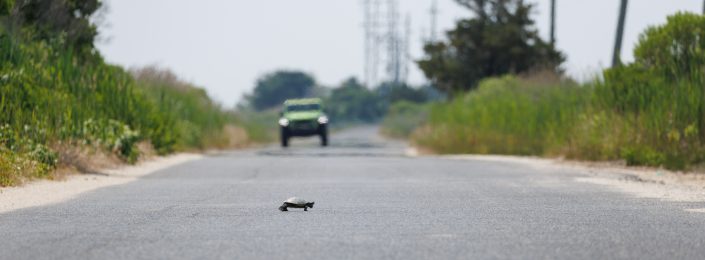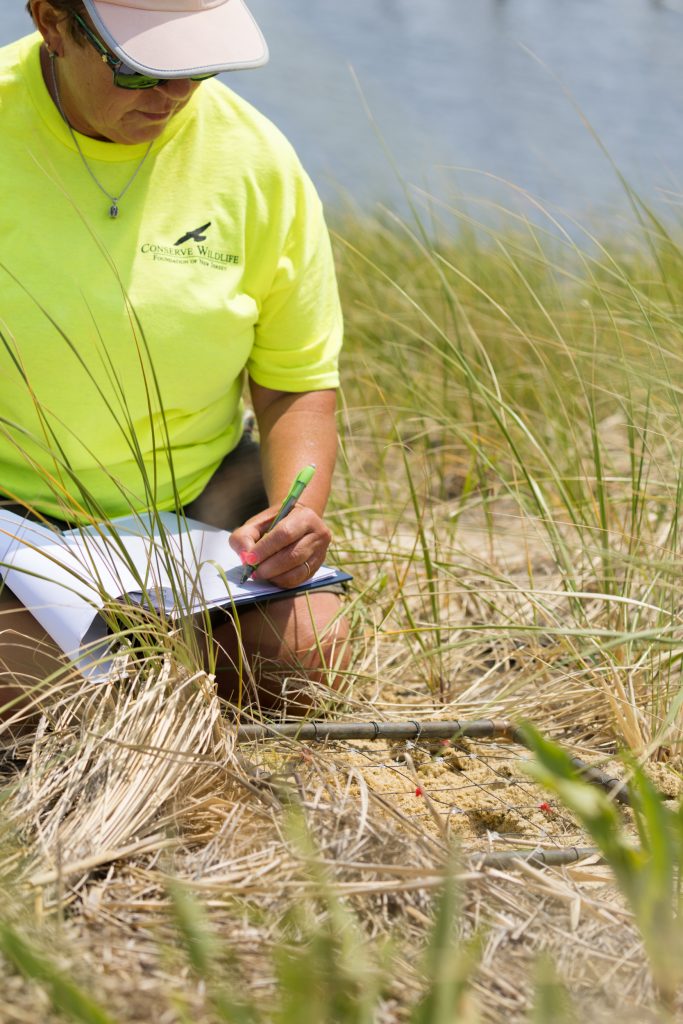Gardening for Terrapins
by Ben Wurst / Senior Wildlife Biologist
Work on this project is done under NJDEP Fish & Wildlife Scientific Collecting Permit SC2023048
When we founded the Great Bay Terrapin Project, our goal was to reduce roadkills of adult female northern diamondback terrapins. This was largely due to personal observations of multiple roadkills during the summer months along roads in Little Egg Harbor Township and past research which accounted for a large number of adults DOR (dead on road). Since 2010, we’ve been able to cut the historic roadkill rate in half, all thanks to our devoted volunteers who patrol area roads and raise awareness for them! This allows adults to grow larger and live longer lives, which helps to ensure their long term survival.
In 2019, we partnered with NJDEP Fish & Wildlife to enhance their nesting habitat. With this project, our goal was to create more suitable habitat for terrapins to nest. We spread over 3000 tons of sand within a .5 acre area and the following year, it was immediately used by terrapins to nest.
Since creating this “turtle garden,” terrapins have naturally found this site and established nests. Each year we monitor to determine use of the habitat that was created. Monitoring consists of watching terrapins nest, searching for nests, and protecting nests w/ metal cages (young are able to leave after hatching). We also monitor for invasive species, like phragmites.
Shortly after we created this site, we met a local resident who was interested in volunteering to monitor the garden. Over the past three years Cindy Varamo has devoted many hours to the success of this site and health of terrapins within the area. This year Cindy is doing research on the turtle garden for the Rutgers University Environmental Stewards Program, which she recently completed. The capstone of the Program is to carry out her own research project.
It made sense to do this research at our turtle garden! As part of her project this summer, she collected data on nest occurrence, dispersion, clutch size and outcomes, in relation to distance from nearby vegetation and other features on site. Her research will help us learn more about the use of this enhancement site which can guide future management efforts, which include control of vegetation or elevation adjustments.
Overall, the site has really transformed into a beautiful landmark, with abundant vegetation that provides habitat for more than just terrapins. As the highest elevation in the area, it provides safe refuge for wildlife during coastal flooding events. When establishing this site, we also planted a lot of grasses and perennials to stabilize the sand while providing habitat and food for wildlife. Now we have full grown bayberry bushes, blooming seaside goldenrod and large clumps of coastal panic grass. We hope to learn from this pilot project and dovetail it into other shoreline stabilization/resiliency projects throughout the state. Soft shorelines are essential for terrapins to access their breeding grounds. As sea level rises, more hard shorelines will be created, which will bisect terrapin habitat.
One final aspect of our project here is to raise awareness for terrapins, especially within the local community. Over the past several years, we have partnered with Dr. John Wnek with Marine Academy for Technical and Environmental Studies (MATES)/Project Terrapin and educators within the Little Egg Harbor School District to head-start a few hatchlings from this region. The goal is to improve their chance of reaching adulthood, while increasing awareness for their local conservation. During this time educators will care for the terrapins to ensure their healthy development, and educate students about terrapins and their life history, so that there is a greater understanding of their threats in the local community.
These head-started hatchlings double or even quadruple in size, during their normal dormant period from October through March. When released the following year, they in turn, have a much higher survival rate and reach sexual maturity at a younger age, thus benefiting the local population. We’re very thankful to work with these devoted volunteers and educators to help ensure terrapins thrive in the local environment.


As I expressed in a previous post, terrapins have A LOT of threats, including illegal collection for the pet trade. They are wild animals and should be left where they were found! I can’t say this enough — Many native turtle species are in danger from illegal collection, which has increased in recent years due to local and worldwide demand. Please do your part to ensure the survival of this species by leaving them where you found them. If by chance you find a hatchling terrapin during this time of year, the best thing to do it put them in saltmarsh habitat as close to where you found them as possible.
If you see someone with a terrapin then you should collect information about that person (vehicle plate #, description of person) and report them to 1-877-WARN-DEP.
Thank you to all our volunteers and donors for supporting our work with terrapins!
#everyturtlecounts
#beterrapinaware
Discover more from Conserve Wildlife Foundation of NJ
Subscribe to get the latest posts sent to your email.




Leave a Comment
What an uplifting blog! So great that the Project and all involved have cut the terrapins D.O.R. in half!! The photos are great too…and don’t I spy a terrapin hidden behind the golden rod in the 4th photo from the top?! In July on LBI, seeing you (Ben) removing eggs from a smashed female and putting the eggs in a sandy “incubator”, I was impressed and saddened. This was both heart-breaking and yet hopeful. Congrats to everyone involved in the Great Bay Terrapin Project and the turtle garden. Keep up that great work!
We had a place at Reeds beach, CMCH, and since we had no bulkhead or barrier between us & Delaware bay, were gratified to have terrapins nesting under our raised house. Volunteered in Dr Wood’s Wetlands institute program, in picking up road killed females to salvage eggs. One thing we noted was the adverse effect of street lights on hatchlings, they were drawn to them rather than to the bay, causing additional mortality. I understand now there are high intensity amber LED lighting which produce a dimmer output with softer light that doesn’t attract turtle hatchlings available. These have been put to use in southern coastal areas for sea turtles. Has this been done in south Jersey?
Hi, Glad to hear about your time spent with Dr. Woods @ Wetlands to help terrapins in S. Jersey! With regards to your question about street lights, I am not sure what the strategy is for installing these new lights. I have seen some but not very many at all. Sounds like installing near the coast should be the priority.
Comments are closed.